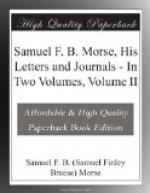There will always be a difference of opinion as to the comparative value of a new discovery and a new invention, and the difference between these terms should be clearly apprehended. While they are to a certain extent interchangeable, the word “discovery” in science is usually applied to the first enunciation of some property of nature till then unrecognized; “invention,” on the other hand, is the application of this property to the uses of mankind. Sometimes discovery and invention are combined in the same individual, but often the discoverer is satisfied with the fame arising from having called attention to something new, and leaves to others the practical application of his discovery. Scientists will always claim that a new discovery, which marks an advance in knowledge in their chosen field, is of paramount importance; while the world at large is more grateful to the man who, by combining the discoveries of others and adding the culminating link, confers a tangible blessing upon humanity.
Morse was completely possessed by this new idea. He worked over it that day and far into the night. His vivid imagination leaped into the future, brushing aside all obstacles, and he realized that here in his hands was an instrument capable of working inconceivable good. He recalled the days and weeks of anxiety when he was hungry for news of his loved ones; he foresaw that in affairs of state and of commerce rapid communication might mean the avoidance of war or the saving of a fortune; that, in affairs nearer to the heart of the people, it might bring a husband to the bedside of a dying wife, or save the life of a beloved child; apprehend the fleeing criminal, or commute the sentence of an innocent man. His great ambition had always been to work some good for his fellow-men, and here was a means of bestowing upon them an inestimable boon.
After several days of intense application he disclosed his plan to Mr. Rives and to others. Objections were raised, but he was ready with a solution. While the idea appeared to his fellow-passengers as chimerical, yet, as we have seen, his earnestness made so deep an impression that when, several years afterwards, he exhibited to some of them a completed model, they, like Captain Pell, instantly recognized it as embodying the principles explained to them on the ship.
Without going deeply into the scientific history of the successive steps which led up to the invention of the telegraph, I shall quote a few sentences from a long paper written by the late Professor E.N. Horsford, of Cambridge, Massachusetts, and included in Mr. Prime’s biography:—
“What was needed to the original conception of the Morse recording telegraph?
“1. A knowledge that soft wire, bent in the form of a horseshoe, could be magnetized by sending a galvanic current through a coil wound round the iron, and that it would lose its magnetism when the current was suspended.




